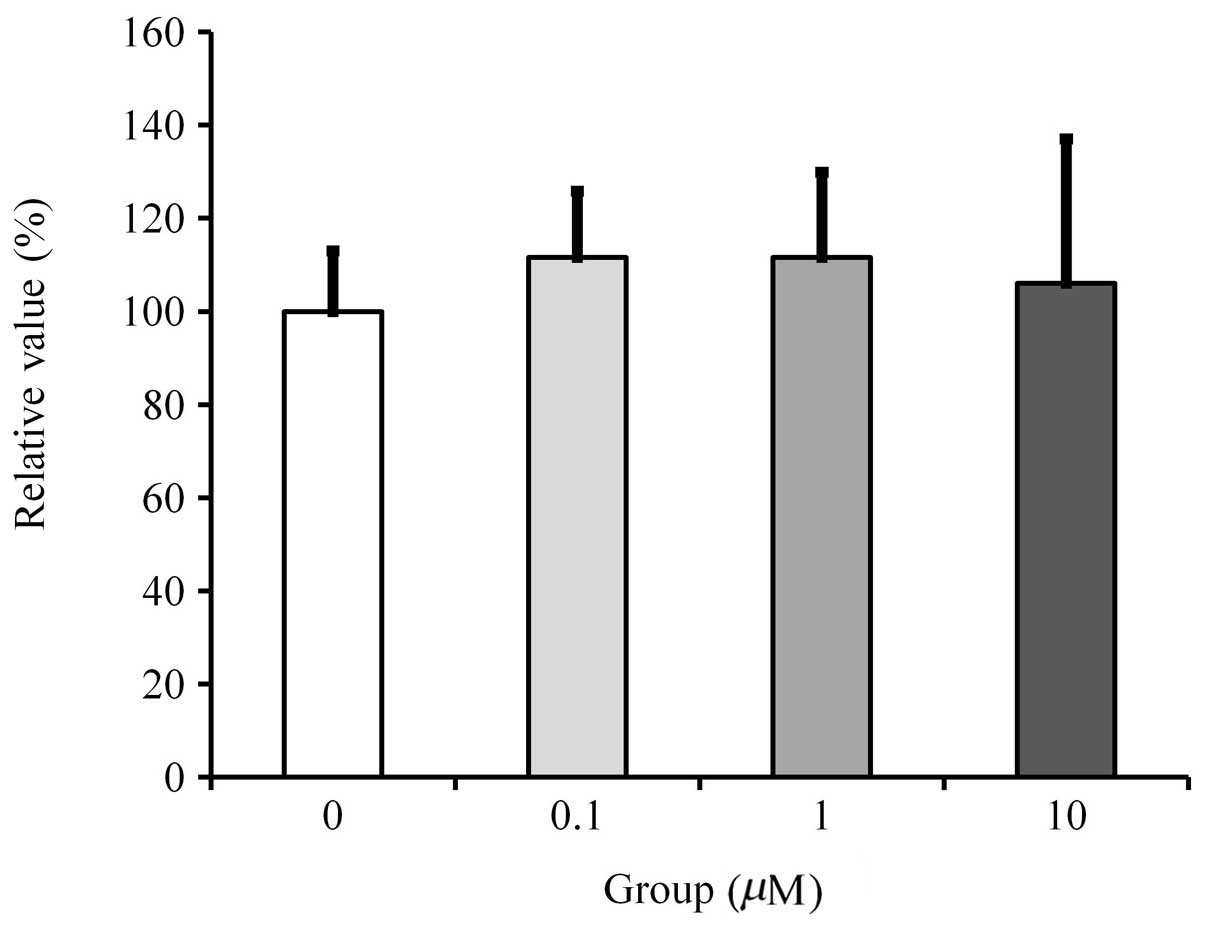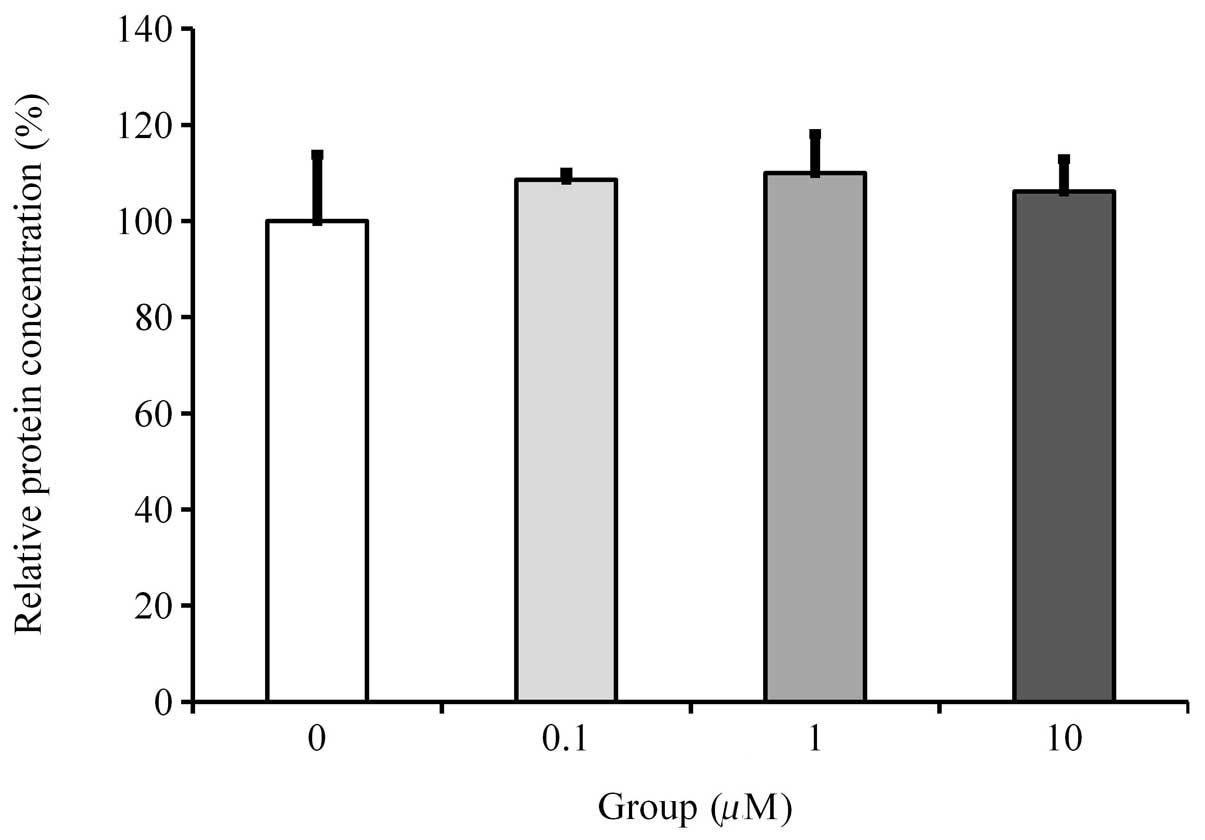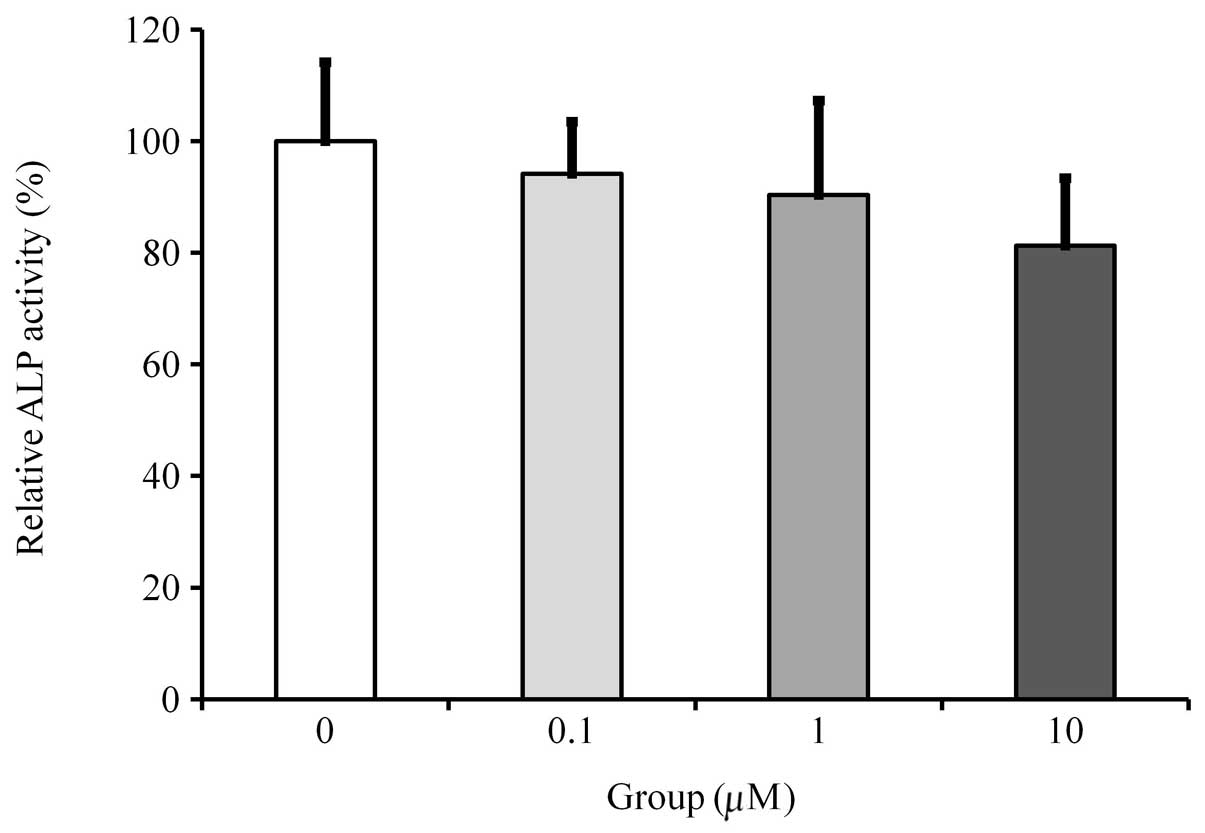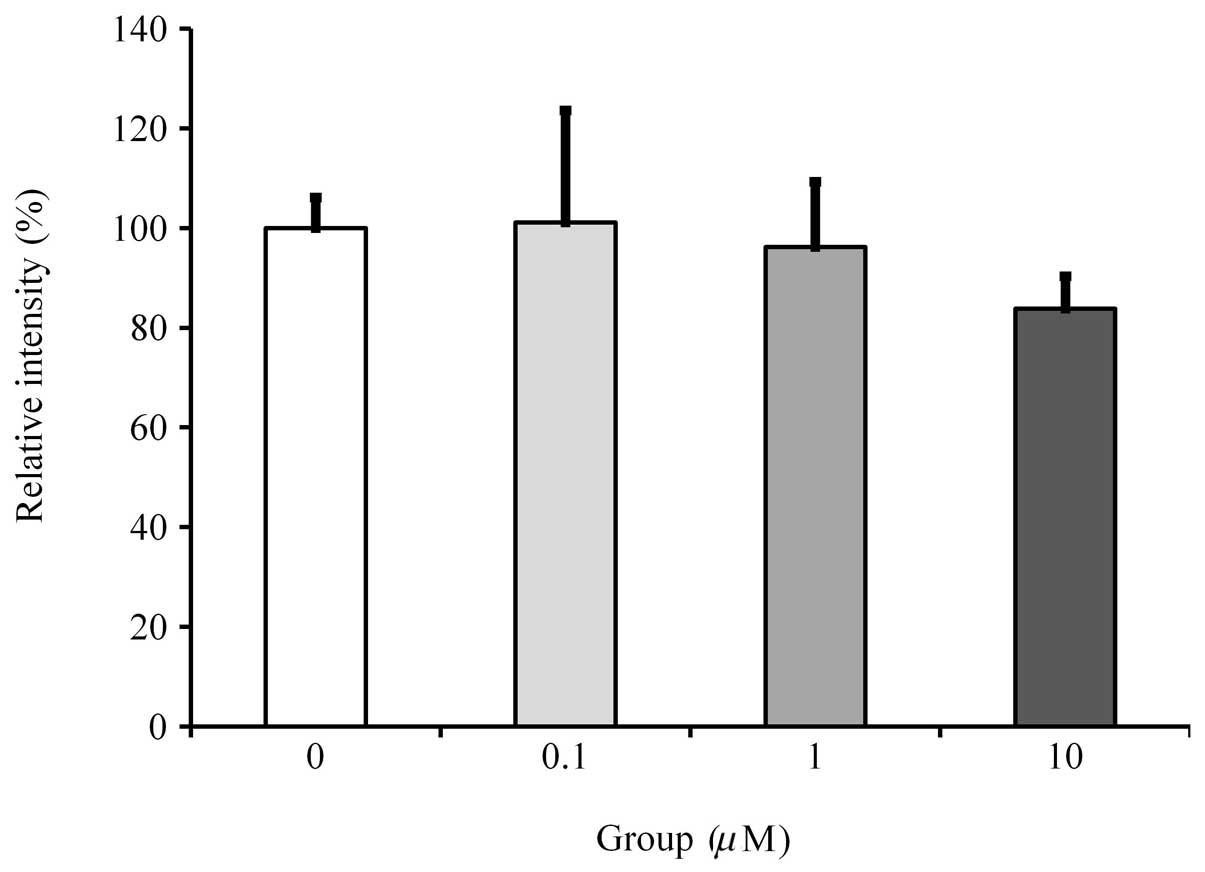The effects of fulvestrant, an estrogen receptor antagonist, on the proliferation, differentiation and mineralization of osteoprecursor cells
- Authors:
- Published online on: November 23, 2012 https://doi.org/10.3892/mmr.2012.1200
- Pages: 555-558
Abstract
Introduction
Estrogen has been shown to exert a variety of pleiotropic effects in target tissues as diverse as bone, breast, blood vessel, brain and the male and female gonads (1). Estrogen plays an important role in the regulation of bone remodeling and maintenance of the skeleton (2,3).
The ability of estrogens to stimulate the transcriptional activity of the estrogen receptor may be inhibited by a diverse range of estrogen antagonists (4). Fulvestrant, or ICI 182,780, is a 7α-alkylsulphinyl analog of estradiol that competes with endogenous estrogen for binding to the estrogen receptor (5). Fulvestrant is a novel type of endocrine treatment and is considered to be a potent inhibitor of breast cancer cells (6). The binding of fulvestrant to the estrogen receptor appears to prevent receptor dimerization and impairs energy-dependent nucleo-cytoplasmic shuttling, consequently blocking nuclear localization of the receptor (4,7). Additionally, the fulvestrant-estrogen receptor complex that enters the nucleus is transcriptionally inactive since the two activation domains AF-1 and -2 are disabled (8). Thus, fulvestrant works by downregulating as well as degrading the estrogen receptor, leading to an inhibition of estrogen signaling through the estrogen receptor (5,9).
Previous studies investigating the effects of fulvestrant on cell proliferation and differentiation have yielded inconsistent results. Low doses of fulvestrant have been shown to inhibit the proliferation of the MCF-7 breast cancer cell line (10) and to inhibit insulin-like growth factor-1 that stimulates cell proliferation (11). A concentration of 0.1 μM of fulvestrant was reported to increase the proliferation of the human fetal osteoblastic cell line, expressing high levels of estrogen receptors (hFOB/ER9) (12). However, no statistically significant difference occurred in the number of cells in the treated (0.1 or 10 μM of fulvestrant) and untreated groups using calvarial osteoblasts (9). The conflicting responses to fulvestrant may be partly attributed to the species differences, the system model, the stage of differentiation of the cells, the culturing period and variable estrogen receptor content among various cell lines and primary cultures (12,13). Moreover, limited studies are available with regard to the effects of fulvestrant on the differentiation and mineralization of osteoblasts (9). The effects of various doses of fulvestrant for bone cells have not yet been fully investigated.
The present study aimed to examine the effects of the fulvestrant at varying doses (0.01–10 μM) on cell proliferation, differentiation and the mineralization of preosteoblasts. Viability was evaluated using the 3-[4,5-dimethylthiazol-2-yl]-2,5-diphenyltetrazolium bromide (MTT) reagents, and the alkaline phosphatase activity (ALP) test and Alizarin red S staining were used to assess the differentiation and mineralization of treated cells, respectively. The expression of proteins associated with bone formation and osteocalcin was evaluated using a western blot analysis.
Materials and methods
Cell culture
MC3T3-E1 murine calvarial preosteoblasts were maintained in α-minimum essential medium (αMEM; Invitrogen, Carlsbad, CA, USA) supplemented with 10% fetal bovine serum (Invitrogen) and antibiotics (100 U/ml of penicillin and 100 μg/ml of streptomycin; Invitrogen). Culture media were changed to an osteogenic differentiation medium [αMEM supplemented with 50 μg/ml ascorbic acid (Sigma-Aldrich, St. Louis, MO, USA)] and 10 mM β-glycerolphosphate (Sigma-Aldrich) to induce osteogenic differentiation. Cells were maintained at 37°C in a humidified 5% CO2 environment. The culture media were replenished with fresh media every three to four days. Fulvestrant, or ICI 182,780, was dissolved in dimethyl sulfoxide (DMSO; Sigma-Aldrich) and filter-sterilized. An equal amount of DMSO was applied in the control and test groups to minimize the effects of DMSO on cell growth and for differentiation between the control and treated cultures. The final concentration of DMSO in the culture never exceeded 0.01%.
Cell proliferation
Cells were plated at a density of 1.0×104 cells/ml/well in 12-well plates and the cultures were stimulated with fulvestrant at final concentrations ranging from 0.01 to 10 μM. The effects of fulvestrant on the proliferation of the preosteoblasts were assessed at Day 4. Cells were incubated for 1 h with the MTT reagent with a final concentration of 0.5 mg/ml (13). Rinsing with phosphate-buffered saline (PBS, pH 7.4) was followed by the addition of DMSO. After complete dissolution with gentle agitation, aliquots were transferred into 96-well plates and absorbance was recorded at 560 and 670 nm using the microplate spectrophotometer system (BioTek, Winooski, VT, USA).
Protein measurement
Cells were plated and cultured in αMEM in the presence of ascorbic acid and β-glycerolphosphate for 14 days. Protein content was determined using the Coomassie Plus Protein Assay Reagent (Pierce Biotechnology, Rockford, IL, USA). Aliquots of standard bovine serum albumin (BSA) or a sample were mixed with the Coomassie reagent and the absorbance was measured at 595 nm using the microplate spectrophotometer system. The results are presented as a percentage of the control values.
ALP activity assays
The ALP assay for osteoblast differentiation was performed at Day 14. Cells were lysed with a buffer containing 10 mM Tris-HCl pH 7.4 and 0.2% Triton X-100 and were then sonicated for 20 sec at 4°C. Samples were incubated with 10 mM p-nitrophenylphosphate as a substrate in 100 mM glycine buffer (pH 10.5) containing 1 mM MgCl2 at 37°C in a water bath (14). Total protein content was determined in comparison with a series of BSA as the internal standards. The absorbance at 405 nm was measured using a microplate reader, and ALP activities were normalized with respect to total protein content (15).
Mineralization assay
A mineralized matrix was detected using Alizarin red S staining for qualitative analysis (9). Cells were washed twice with PBS, fixed with 70% ethanol in ice-cold PBS for 1 h and rinsed twice with deionized water. The cultures were stained with 40 mM Alizarin red S (Sigma-Aldrich) for 30 min under gentle agitation. For quantification, cells stained with Alizarin red S were destained with 10% cetylpyridinium chloride by agitation. Extracted stain (200 μl) was transferred to a 96-well plate and the absorbance 562 nm was determined spectrophotometrically.
Western blot analysis
Cells were washed twice with ice-cold PBS and solubilized with lysis buffer containing 10 mM Tris-HCl pH 7.4, 0.2% Triton X-100. The lysates were centrifuged at 14,000 rpm for 20 min at 4°C to remove the nuclear pellet. The supernatants were boiled in a sodium dodecyl sulfate sample buffer containing β-mercaptoethanol. Equal amounts of cell extracts were separated by sodium dodecyl sulfate-polyacrylamide gel electrophoresis and then transferred onto polyvinylidene fluoride microporous membrane (Immobilon-P membranes; Millipore Corporation, Billerica, MA, USA). Membranes were then blocked in 0.1% (v/v) PBS and Tween-20 containing 5% (w/v) powdered milk for at least 1 h. The membrane was immunoblotted with the desired mouse antibodies against osteocalcin (Santa Cruz Biotechnology, Inc., Santa Cruz, CA, USA) diluted in the same buffer at the recommended concentrations. The membrane was incubated with horseradish peroxidase-conjugated secondary antibody and then the washed blot was developed using enhanced chemiluminescence detection kits (16).
Statistical analysis
Results are presented as the mean ± standard deviation of the experiments. One-way analysis of variance (ANOVA) was performed to determine differences between groups using commercially available software (SPSS 12 for Windows, SPSS, Inc., Chicago, IL, USA). P<0.05 was considered to indicate a statistically significant difference.
Results
Cell proliferation
Cultures grown in the presence of fulvestrant at a concentration of 0.1 to 10 μM did not show any significant change in cell proliferation (Fig. 1).
Viability/proliferation of the cells with protein measurement
The protein concentration of the cultures grown in osteogenic differentiation medium at Day 14 did not show any significant differences between the observed groups (Fig. 2).
ALP activity assays
Cultures growing in the absence of fulvestrant exhibited the highest value for the ALP activity. Cultures grown in the presence of fulvestrant showed dose-dependent reductions in ALP activity, however, statistically significant differences were not achieved in the observed groups (Fig. 3).
Mineralization/calcium deposition assay
Cultures without fulvestrant showed the highest rate of mineralized nodule formation. Results showed that cultures grown in the presence of fulvestrant presented with a dose-dependent reduction in mineralization. However, statistically significant differences were observed only in the 10 μM concentration group (Fig. 4).
Western blot analysis
Western blot analysis was performed to detect protein expression following treatment with fulvestrant (Fig. 5). The results showed that the addition of fulvestrant decreased the expression of osteocalcin (Fig. 6). Normalization of the protein expression demonstrated that the group treated with 10 μM fulvestrant yielded 83.8±6.5%, when cultures without fulvestrant were considered to be 100%, however, this did not reach a statistically significant level (P>0.05).
Discussion
The present study examined the effects of low doses of fulvestrant on cell viability, and the differentiation and mineralization of osteoblast progenitor cells under predetermined concentrations (0.1–10 μM).
Viability and proliferation were evaluated using the MTT assay and protein concentration. The MTT assay is an extremely sensitive method for determining cell proliferation since this assay allows mitochondrial dehydrogenases to oxidize MTT to an insoluble blue formazan product (17,18). The protein assay may be considered an indirect measurement of cell viability as it measures the protein content of the viable cells remaining after washing the cell plates (19). Equal amounts of DMSO were added to each culture sample to offset the influence of the dissolving vehicle (13). The results showed no significant effect of fulvestrant on cell number. Thus, changes in protein expression or mineral levels in the groups may be attributed to changes in the ability of the osteoblasts to produce minerals rather than to changes in the number of cells present (9,20).
ALP activity, which is considered to be an early marker of osteoblastic cell differentiation, was used to determine osteoblast differentiation (14). Cultures grown in the presence of fulvestrant showed a dose-dependent reduction in ALP activity, yet statistically significant differences were not achieved. Osteocalcin is an osteoblast-specific gene expressed by fully differentiated osteoblasts (21). Western blot analysis showed that 10 μM fulvestrant yielded a decrease in protein expression, however not at a statistically significant level. In a previous study, osteocalcin expression was significantly reduced in 0.1 μM fulvestrant at Day 28, which may be the result of the longer period of culture (9).
Moreover, cultures grown in the presence of fulvestrant presented with a dose-dependent reduction in mineralization with a statistically significant difference at 10 μM concentration. However, previous studies have showed that treatment with fulvestrant alone at either 0.1 or 10 μM did not result in significant changes in mineralization (9). The various responses to fulvestrant may be attributed in part to the culturing period, the stage of differentiation of the cells or the culturing condition (22).
The effect of fulvestrant on bone mineralization remains controversial (5,9). Fulvestrant reduced bone volume at the proximal tibial metaphysis by ~30%, associated with an increase in osteoclast surface, while the authors suggested that this was attributable to antagonization of the actions of estrogen (23). Likewise, the increase in calcium content by 17β-estradiol was completely inhibited by the fulvestrant (24), and co-treatment of estrogen and fulvestrant resulted in a significant reduction of mineralization (9). However, bone mineral density in rats was not altered by administration of fulvestrant at anti-uterotrophic doses, unlike the significant reduction that occurred following an ovariectomy (25), and mineralization by osteoblastic cells was not altered in an estrogen-deficient environment using calvarial osteoblasts (MC3T3 cells). Further elucidation of the mechanisms by which fulvestrant affects bone may have the potential to improve the clinical management of fulvestrant usage.
These findings support the conclusion that the use of fulvestrant may have negative effects on the mineralization of osteoprecursor cells and that the long-term use of fulvestrant may have detrimental effects on osteoblastic activity.
Acknowledgements
This study was supported by the Bioethics Expert Development Fund of the Committee for Life in the Archdiocese of Seoul.
References
|
Dechering K, Boersma C and Mosselman S: Estrogen receptors alpha and beta: two receptors of a kind? Curr Med Chem. 7:561–576. 2000. View Article : Google Scholar : PubMed/NCBI | |
|
Song C, Wang J, Song Q, et al: Simvastatin induces estrogen receptor-alpha (ER-alpha) in murine bone marrow stromal cells. J Bone Miner Metab. 26:213–217. 2008. View Article : Google Scholar : PubMed/NCBI | |
|
Park JB: Effects of low dose of estrone on the proliferation, differentiation and mineralization of osteoprecursor cells. Exp Ther Med. 4:681–684. 2012.PubMed/NCBI | |
|
Dauvois S, Danielian PS, White R and Parker MG: Antiestrogen ICI 164,384 reduces cellular estrogen receptor content by increasing its turnover. Proc Natl Acad Sci USA. 89:4037–4041. 1992. View Article : Google Scholar : PubMed/NCBI | |
|
Curran M and Wiseman L: Fulvestrant. Drugs. 61:807–814. 2001. View Article : Google Scholar : PubMed/NCBI | |
|
Osborne CK, Wakeling A and Nicholson RI: Fulvestrant: an oestrogen receptor antagonist with a novel mechanism of action. Br J Cancer. 90(Suppl 1): S2–S6. 2004. View Article : Google Scholar : PubMed/NCBI | |
|
Fawell SE, White R, Hoare S, Sydenham M, Page M and Parker MG: Inhibition of estrogen receptor-DNA binding by the ‘pure’ antiestrogen ICI 164,384 appears to be mediated by impaired receptor dimerization. Proc Natl Acad Sci USA. 87:6883–6887. 1990. | |
|
Nicholson RI, Gee JM, Manning DL, Wakeling AE, Montano MM and Katzenellenbogen BS: Responses to pure antiestrogens (ICI 164384, ICI 182780) in estrogen-sensitive and -resistant experimental and clinical breast cancer. Ann NY Acad Sci. 761:148–163. 1995. View Article : Google Scholar : PubMed/NCBI | |
|
Brennan O, O’Brien FJ and McNamara LM: Estrogen plus estrogen receptor antagonists alter mineral production by osteoblasts in vitro. Horm Metab Res. 44:47–53. 2012. View Article : Google Scholar : PubMed/NCBI | |
|
Lykkesfeldt AE, Larsen SS and Briand P: Human breast cancer cell lines resistant to pure anti-estrogens are sensitive to tamoxifen treatment. Int J Cancer. 61:529–534. 1995. View Article : Google Scholar : PubMed/NCBI | |
|
de Cupis A, Noonan D, Pirani P, Ferrera A, Clerico L and Favoni RE: Comparison between novel steroid-like and conventional nonsteroidal antioestrogens in inhibiting oestradiol- and IGF-I-induced proliferation of human breast cancer-derived cells. Br J Pharmacol. 116:2391–2400. 1995. | |
|
Robinson JA, Harris SA, Riggs BL and Spelsberg TC: Estrogen regulation of human osteoblastic cell proliferation and differentiation. Endocrinology. 138:2919–2927. 1997.PubMed/NCBI | |
|
Park JB, Zhang H, Lin CY, et al: Simvastatin maintains osteoblastic viability while promoting differentiation by partially regulating the expressions of estrogen receptors α. J Surg Res. 174:278–283. 2012.PubMed/NCBI | |
|
Park JB: The effects of dexamethasone, ascorbic acid, and β-glycerophosphate on osteoblastic differentiation by regulating estrogen receptor and osteopontin expression. J Surg Res. 173:99–104. 2012. | |
|
Park JB: Combination of simvastatin and bone morphogenetic protein-2 enhances differentiation of osteoblasts by regulating the expression of phospho-Smad1/5/8. Exp Ther Med. 4:303–306. 2012.PubMed/NCBI | |
|
Park JB: Effects of fibroblast growth factor 2 on osteoblastic proliferation and differentiation by regulating bone morphogenetic protein receptor expression. J Craniofac Surg. 22:1880–1882. 2011. View Article : Google Scholar : PubMed/NCBI | |
|
Park JB: Effects of doxycycline, minocycline, and tetracycline on cell proliferation, differentiation, and protein expression in osteoprecursor cells. J Craniofac Surg. 22:1839–1842. 2011. View Article : Google Scholar : PubMed/NCBI | |
|
Almazin SM, Dziak R, Andreana S and Ciancio SG: The effect of doxycycline hyclate, chlorhexidine gluconate, and minocycline hydrochloride on osteoblastic proliferation and differentiation in vitro. J Periodontol. 80:999–1005. 2009. View Article : Google Scholar : PubMed/NCBI | |
|
Fotakis G and Timbrell JA: In vitro cytotoxicity assays: comparison of LDH, neutral red, MTT and protein assay in hepatoma cell lines following exposure to cadmium chloride. Toxicol Lett. 160:171–177. 2006. View Article : Google Scholar : PubMed/NCBI | |
|
Qu Q, Perälä-Heape M, Kapanen A, et al: Estrogen enhances differentiation of osteoblasts in mouse bone marrow culture. Bone. 22:201–209. 1998. View Article : Google Scholar : PubMed/NCBI | |
|
Qi H, Aguiar DJ, Williams SM, La Pean A, Pan W and Verfaillie CM: Identification of genes responsible for osteoblast differentiation from human mesodermal progenitor cells. Proc Natl Acad Sci USA. 100:3305–3310. 2003. View Article : Google Scholar : PubMed/NCBI | |
|
Quarles LD, Yohay DA, Lever LW, Caton R and Wenstrup RJ: Distinct proliferative and differentiated stages of murine MC3T3-E1 cells in culture: an in vitro model of osteoblast development. J Bone Miner Res. 7:683–692. 1992. View Article : Google Scholar : PubMed/NCBI | |
|
Gallagher A, Chambers TJ and Tobias JH: The estrogen antagonist ICI 182,780 reduces cancellous bone volume in female rats. Endocrinology. 133:2787–2791. 1993.PubMed/NCBI | |
|
Sato K, Nohtomi K, Shizume K, et al: 17 beta-estradiol increases calcium content in fetal mouse parietal bones cultured in serum-free medium only at physiological concentrations. Bone. 19:213–221. 1996. View Article : Google Scholar | |
|
Wakeling AE: The future of new pure antiestrogens in clinical breast cancer. Breast Cancer Res Treat. 25:1–9. 1993. View Article : Google Scholar : PubMed/NCBI |















